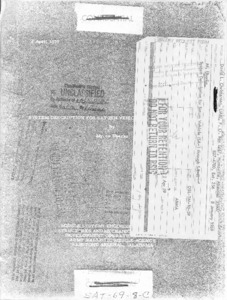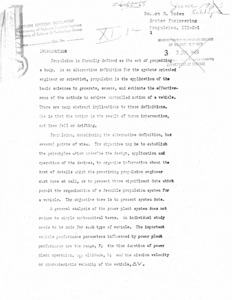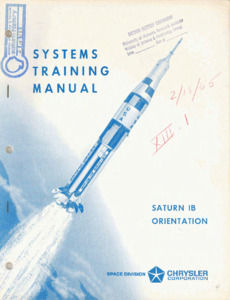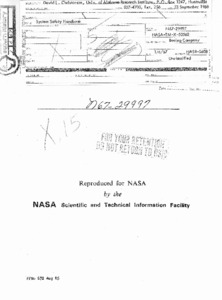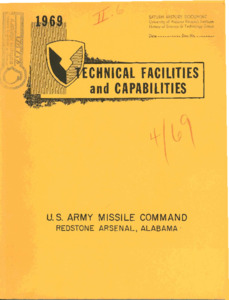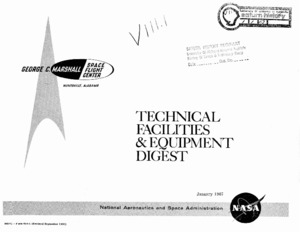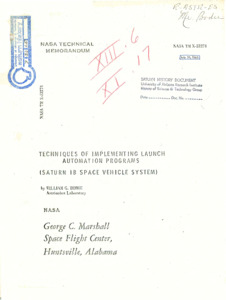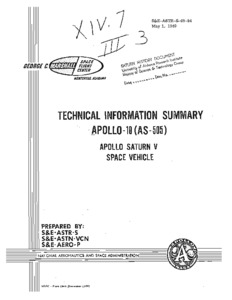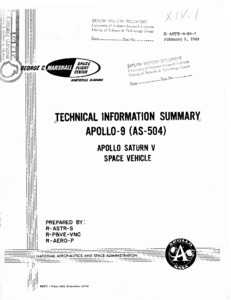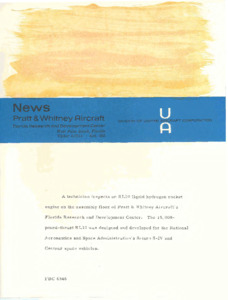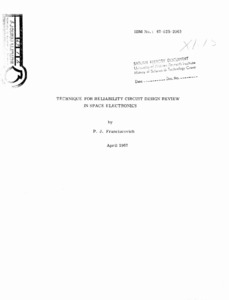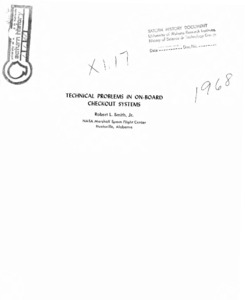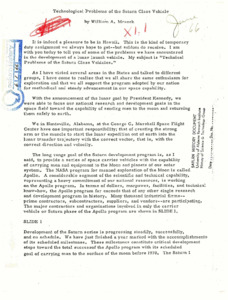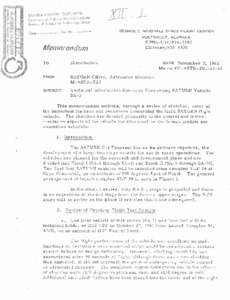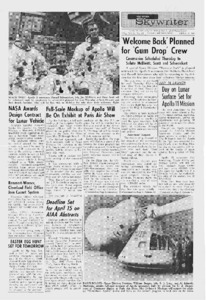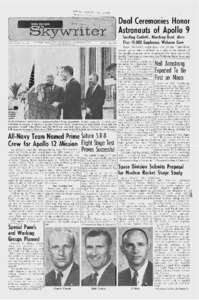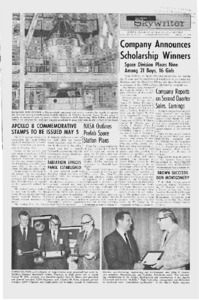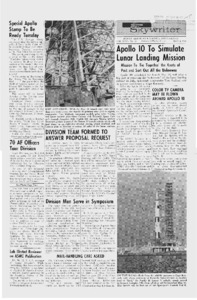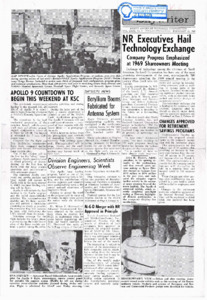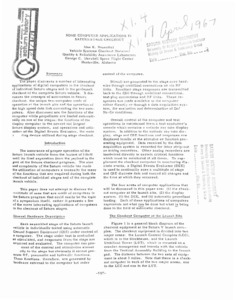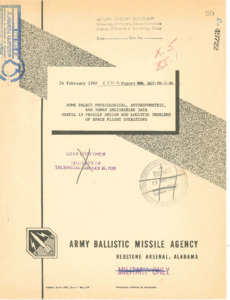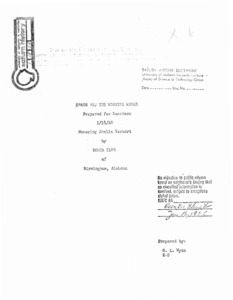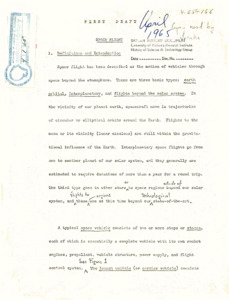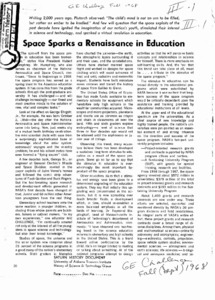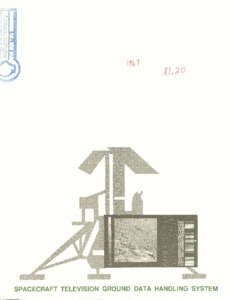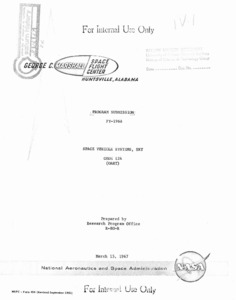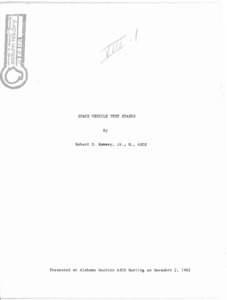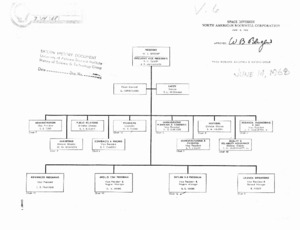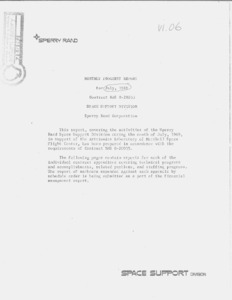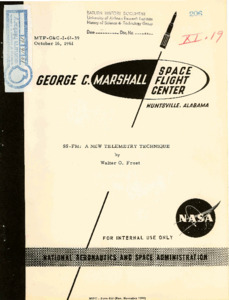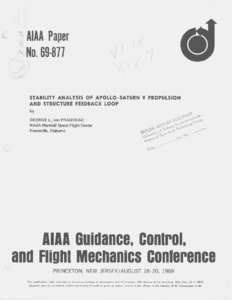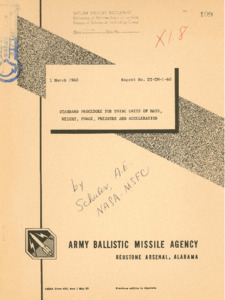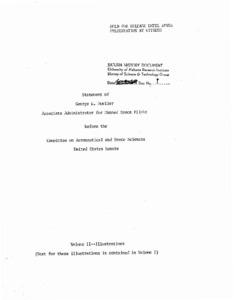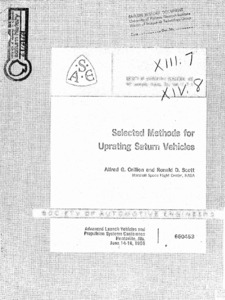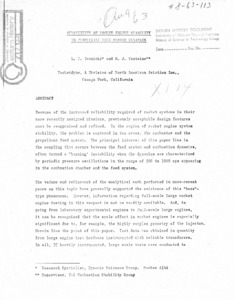
Browse Items (716 total)
Sort by:
-
"System description for Saturn vehicle (SA-1 through SA-4)."
Missing pages iv, 3, 6 to 8. Photocopy of files containing sections of the project. -
"System engineering propulsion, III-C-1."
Page numbering is inconsistent; there are no pages numbered 14 - 17. Some pages have handwritten numbers, others have no numbers at all.; The print quality of many pages is poor. Discusses the definition and function of propulsion as well as how to most effectively employ it . -
"Saturn IB orientation training manuel."
Prepared through joint efforts of Personnel Department, Education and Development Branch, Systems Training Unit, Michoud Operations and Engineering Communications Department, Technical Information Branch, Applied Communications Engineering Section, Huntsville Operations.; This publication presents a brief descriptive summary of the Saturn IB vehicle and Chrysler's Corporation's accomplishments in the missiles and space field. The Saturn IB information presented herein is based on current plans for each of the stages. Although there may be design changes from vehicle to vehicle, the basic components, systems, and operating principles will remain similar to previous models. -
"System safety handbook."
The testing of a hardware system consists of' subjecting it to carefully controlled operating conditions for the purpose of demonstrating that this system performs its function properly. -
Technical facilities and capabilities 1969.
This brochure is being distributed to colleges and universities to acquaint and interest their students, at all acadmic levels, with the wide variety of professional and technical skills that are essential to accomplish the complex mission of the Army Missile Command, located at Redstone Arsenal, enar Huntsville, Alabama. -
"Technical facilities & equipment digest."
This document portrays the capability of technical facilities and equipment at the George C, Marshall Space Flight Center (MSFC) , one of three basic field centers under the NASA Office of Manned Space Flight. -
"Techniques of implementing launch automation programs" (Saturn IB space vehicle system).
This paper identifies the methods and equipment through which automation is becoming a major factor in testing and launching Saturn IB space vehicles. The merits of a digital guidance computer and its impact in extending automated checkout are stressed; also a logical basis is established for computer and manual test control. Hardware and software elements of the automated system are described, and details pertaining to reliability are emphasized. A concluding appraisal suggests that automation will play an expanding role in future test and launch operations. -
"Technical information summary Apollo-10 (AS-505) Apollo Saturn V space vehicle."
The document presents a brief and concise description of the AS-505 Apollo Saturn Space Vehicle. Where necessary, for clarification, additional related information has been included. -
"Technical Information Summary Apollo-9 (AS-504) Apollo Saturn V Space Vehicle."
The document presents a brief and concise description of the Apollo 9 Saturn Space Vehicle. -
"Technical information summary concerning Saturn vehicle SA-3."
This memorandum outlines, through a series of sketches, some of the important features and sequences concerning the third SATURN flight vehicle. The sketches are devoted primarily to the control and instrumentation aspects of the vehicle but also touch on the launch facility and countdown schedule. -
"Technician inspects an RL10 liquid hydrogen engine."
A technician inspects an RLlO liquid hydrogen rocket engine OD the assembly floor. of Pratt & Whitney Aircraft's Florida Research and Development Center. The 115,000-pound-thrust RLlO was designed and developed for the National Aeronautics and Space Administration's Saturn S-IV azld Centaur space vehicles. -
"Technique for reliability circuit design review in space electronics."
Design review is becoming a basic requirement during the design and development of military systems. The main purpose of the design review is to increase the system's inherent and operational reliability. The major portion of this paper is the result of reliability's effort to comply with Paragraph 3.6 of NPC 250-1 Reliability Program Provisions for Space Contractors. The design review to be discussed is a reliability circuit design review with emphasis placed on what should be reviewed and the review techniques employed. The basic circuit design review prerequisites, component parts and their ratings, are discussed at the beginning of this paper. The remainder deals with the organization and reviewing of circuits. The review items include worst-case circuit performance, component applications, failure mode analysis, noise rejection, electrical stress, and the determination of component temperatures. Many examples are included to illustrate how each item was accomplished. This paper is intended not only to give the reliability analyst cognizance of basic design problems and troublesome circuits, but also, to aid him in formulating a design review program. -
"Technical problems in on-board checkout systems."
For the purposes of this paper, an onboard checkout system is defined as a system which is built into prime flight equipment, flies with it, and permits a checkout capability to exist during all the major phases of the test and mission life of that prime equipment. Varying degrees of capability may exist in such a system, depending on what is designed into it. This, in turn, is generally dependant on life and mission requirements of the prime equipment, degree of mission checkout required, reliability restrictions,redundancy levels, data management scheme, and equally important, state of the art . Not all checkout can be accomplished with onboard equipment. Mechanical system problems such as leak detection, for example, require techniques that cannot be remotely controlled and evaluated today. On the other hand, such things as in-flight telemetry have been used for quite a long time and will continue to be used for onboard checkout. -
"Technological problems of the Saturn class vehicle."
Aerospace Workshop. University of Hawaii.; Includes references to slides. -
"Technical information summary concerning Saturn vehicle SA-3."
This memorandum outlines, through a series of sketches, some of the important features and sequences concerning the third SATURN flight vehicle. The sketches are devoted primarily to the control and instrumentation aspects of the vehicle but also touch on the launch facility and countdown schedule. -
"Welcome back planned for 'Gum Drop' crew."
A news article detailing the festivities planned upon the return of nine astronauts returning from a 10-day mission. -
"Dual ceremonies honor astronauts of Apollo 9."
A news article detailing the 'welcome back' ceremony for the nine astronauts who had just returned from a 10-day mission. -
"Company announces scholarship winners: Space Division places 9 of 21 boys and 16 girls."
A news article detailing the winners of scholarships from a competition held by Space Division. This contest was held for the children of Space Division employees. -
"Apollo 10 to simulate lunar landing mission."
A news article describing that Apollo 10's goal is to simulate a lunar landing in preparation for the real mission. -
"NR executives hail technology exchange."
A news article detailing a Technology Exchange event held by North American Rockwell Corperation. -
"Some computer applications in Saturn stage checkout."
This paper discusses a number of interesting applications of digital computers in the checkout of individual Saturn stages and in the prelaunch checkout of the complete Saturn vehicle. It discusses the concepts of automation in Saturn checkout, the unique two-computer mode of operation at the launch site and the operations of the high speed data link connecting the two computers. Also discussed are the functions of the computer while propellants are loaded automatically on one of the stages; the functions of the display computer in the newest and largest Saturn display system, and operations and utilization of the Digital Events Evaluator, the main recording device utilized during stage checkout. -
"Some select physiological, anthropometric, and human engineering data useful in vehicle design and logistic problems of space flight operations."
Report No. DSP-TM-2-60 31 p.; Pages which were blank (not scanned): 2, 26, 28 -
"Space age management or maintenance of technical capability during a period of retrenchment."
On January 3Ist of this year the United States celebrated its tenth anniversary in Space. In just one decade we have seen our space program climb from an humble beginning (a 30.8-pound payload put into orbit with a jury-rigged rocket) to extra-vehicular-activity and the tremendous Saturn V vehicle capable, of putting 250,000 pounds into low earth orbit. We have seen it grow from a "quick and dirty" operation to a program which at its peak had approximately 380,000 industrial employees in excess of {dollar}5.O billion per year. The marshalling of this great management and technological team generated many "growing pains". A few years ago the hue and cry was, "Where are we going to get sufficient people with scientific knowledge and drive to implement the space program?" Industry, sometimes reluctantly, was pressed into tasks which required managerial and technical skills beyond those they then possessed. -
"Space and the working woman."
Memorandum prepared for the honoring Amelia Earhart by the Zonta Club, Birmingham, Alabama. -
"Space flight : first draft."
Appears to be a rough dfraft with editorial comments and revision notes. Includes references to figures and tables.; Page 31 is missing. Pages 37 through 44 do not exist; there is a note about this on page 36. Page 67 also does not exist. -
"Space flight projects - today and tomorrow."
NASA symposium on scientific and technical Information. -
"Space sparks a renaissance in education."
An article which comments on the increasing interest in science and education due to the greater understanding of space. -
"Spacecraft television ground data handling system."
A design report which displays and explains how the Spacecraft Television Ground Handling System functions, is designed and what it might be used for in the future. -
Space vehicles for the peaceful exploration of the inner solar system; Memorandum to Mr. K. K. Dannenberg from Joe M. Jones.
Review of speech to be presented in Tampa, FL. Speech included references to slides. -
"Space vehicle systems" research and technology.
A collection of various graphs, resumes and recordings for space vehical systems. -
"Space vehicle test stands."
One of the pacing items in this Nation's accelerated space program is the construction of facilities for the manufacture, development, testing, check-out, transportation and launching of space vehicles. Behind each successful launching are countless hours of effort in development, quality and reliability checks and tests of engines, components, boosters, and stacked stages; including pressure tests, cold-flow tests and hot firing (or static) tests; all to assure the safest possible trip for the men or instrumentation in the space craft. -
"Space Division, North American Rockwell Corporation Organizational Chart."
Organization chart for North American Rockwell, 1968 -
"Sperry Rand monthly progress report for July, 1969."
The following pages contain reports for each of the individual contract appendices covering technical progress and accomplishments, related problems, and staffing progress. The report of manhours expended against each appendix by schedule order is being submitted as a part of the financial management report. -
"A new telemetry technique."
A technique new to telemetry is discussed which promises to alleviate an enigma facing the telemetry engineer : How to adequately transmit the avalanche of vibration and other wideband data desired in the development phase of large missiles and launch vehicles. The data channels are stacked in the frequency spectrum as single sideband subcarriers which frequency modulate the RF carrier. The system design utilizes to advantage the statistical properties of vibration data to achieve maximum data transmission efficiency from the available RF carrier deviation. However, in contrast to proposed statistical predigestion techniques, the data is transmitted in raw form. -
"Stability analysis of Apollo - Saturn V propulsion and Structure feedback loop."
The propulsion and the structure of a space vehicle form a feedback loop through inertial coupling referred to as the pogo phenomenon and experienced with the Thor , Titan, and Apollo-Saturn V space vehicles. -
"Standards of conduct for NASA employees."
NASA handbook which establishes what code of conduct is acceptable as a representative of the company and what behavior is not. -
"Standard procedure for using units of mass, weight, force, pressure and acceleration."
Report No. DT-TM-1-60. ; FORWARD: The field of missiles and rockets deals with quantities of matter at various locations with different accelerations of gravity. The weight of these masses changes with gravity and the measurements of liftoff weight, fuel weight, etc., result in different values, depending on whether mass or weight units are used. Pressure and thrust are independent of the acceleration of gravity, but the instruments for measuring these values are calibrated with standard masses, producing different weight forces and calibration curves at different locations. Most sections of ABMA and other agencies or companies use pounds or kilograms as units of mass, weight or force, and the influences of different accelerations of gravity are often disregarded or treated incorrectly. These discrepancies become increasingly unacceptable with larger missiles and greater distances between operation sites. Therefore, the following Standard Procedure has been prepared to insure consistent and uniform terms and units of mass, weight, force, pressure and acceleration. All sections and individuals concerned are urged to use these units andprocedures. This is signed by Dr. Wernher von Braun, Director Development Operations Division. -
"Statement of George E. Mueller, Associate Administrator for Manned Space Flight before the Committee on Aeronautical and Space Sciences, United States Senate."
Presentation of George Mueller before congress. Contains illustrations. -
"Selected methods for uprating Saturn vehicles."
This paper will discuss selected methods for increasing the Saturn launch vehicle payload capabilities. These methods involve system changes or additions that give large step performance'increases aver those which can be obtained by product improvements. The selected philosophy of approach and the established designed systems wil1,be described, as well as anticipatedsystem concepts that may be used to increase the Saturn vehicles' capabilities. -
"Sensitivity of rocket engine stability to propellant feed system dynamics."
Because of the increased reliability required of rocket systems in their more recently assigned missions, previously acceptable design features must be reappraised ad refined. In the region of rocket engine system stability, the probles is centered in two areas, the combustor and the propellant feed system The principal interest of this paper lies in the coupling that occurs between the feed system and combustion dynamics, often termed a "buzzing" instability then the dymics are characterized by periodic pressure oscillations in the range of 200 to 1000 cps appearing in the combustion chamber and' the feed system.
